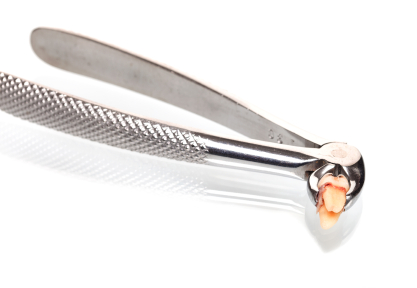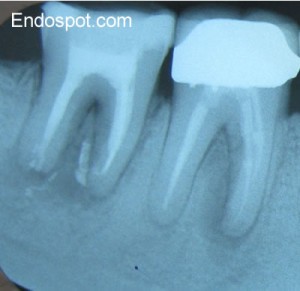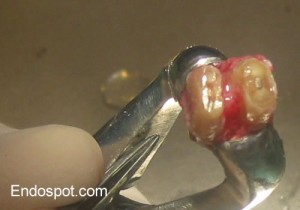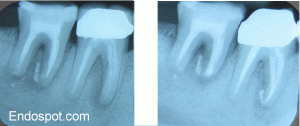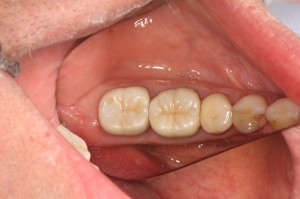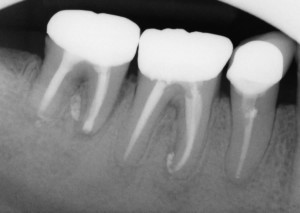Every dentist has had the unfortunate experience of being unable to achieve anesthesia, especially when dealing with an irreversibly inflamed dental pulp. You find yourself filled with self-doubt and feeling helpless, especially where the patient has presented in pain and you feel you need to remove that inflamed pulp!
But, LA failure is a bit more complex than I think most of us realise. Most of the information that follows is taken from an excellent review of the topic by Ken Hargreaves & Karl Keiser, so grab that if you want in depth analysis (Hargreaves et al. 2002). I’m going to cover what I think is important for most of us.
There are a number of reasons for LA Failure, but the first thing I think we should consider is this:
1. Complete pulpal anesthesia is not achieved 100% of the time in normal pulps;
2. Complete pulpal anesthesia has a slower onset than most of us would expect .
The simple fact is that a well administered inferior alveolar nerve block does not provide complete pulpal anesthesia 100% of the time. Bou Dagher conducted IAN block on 30 subjects and achieved 100 numbness of the lip, but only 50-75% of these patients demonstrated complete molar anesthesia when measured by electric pulp tester (Bou Dagher 1997). For most dentists, the majority of LA is given for restorative procedures, and often, anesthesia may be sufficient to prepare a cavity for restoration without problem. I think this probably lulls us into a false sense of security as to how successful our techniques are.
The next point to make is that the onset of complete pulpal Anesthesia takes time, most commonly up to 15 minutes. It’s fair to say that we would often not wait that long before attempting a procedure. In studies, onset was longer than 15 minutes in 19-27% of cases and longer than 30 minutes in 8% of cases. Complete lip numbness occurred much faster, within 5-7 minutes.
On this topic, It has been shown that injecting a second cartridge of LA injected after an apparently successful IAN block does not improve the onset time (Vreeland et al. 1989). In those situations where we have an apparently failed IAN block (despite profound lip numbness), and we inject a second cartridge and we then achieve anesthesia, it’s probably just that we’ve allowed more time for the initial injection to work.
The key points here are:
1. Lip numbness does not confirm pulpal anesthesia;
2. Onset takes time
3. IAN blocks are unreliable when it comes to achieving pulpal anesthesia even in uninflamed pulps
What happens when we have an inflamed pulp? Things are even more dire. Two studies that evaluated pulpal anesthesia after IAN where the pulp was inflamed reported an average of only 55%, despite 100% numbness of the lip (Cohen et al. 1993, Nusstein et al. 1998).
Theories on failure of LA
It is my recollection from reading textbooks at dental school that IAN blocks failed because of the increased pH in the region of an inflamed pulp which prevented dissociation from the acid form of the LA to the base form. The base form was then unable to diffuse across the cell membrane in order to block the sodium channel. This never sat well with me because I couldn’t understand why inflammation at the site of a lower canine tooth would affect the dissociation of an LA molecule deposited near the mandibular foramen. The truth is that while this theory remains a possibility, it is unlikely that this is a real explanation for the failure of LA. Firstly, the change in pH in inflamed tissues is not large, and inflamed tissues possess a greater buffering ability than normal tissues. Secondly, any change in tissue pH is also likely to be very localised (Punnia-Moorthy, 1988). So, given our clinical results of reduced anesthesia of mandibular teeth after IAN blocks, we can consider this explanation to have some, but probably limited clinical relevance.
The second reason I recall from dental school for failure of IAN blocks was accessory innervation from the myelohyoid nerve. The lingual, buccal and transverse cervical nerve have also been implicated, however there is limited evidence for these mechanisms. Potentially, however, they could contribute to LA failure.
A third possible method mentioned in the literature is resistance or tachyphylaxis. According to Kenneth Hargreaves (who by the way is an extraordinary speaker and you should make an effort to see him speak) there is little evidence for this, and I think we should be happy to take his word for it.
The next possible mechanism of failure of LA is through the increased blood flow that occurs in inflamed tissues. This could potentially result in increased removal of LA from a site. Again, this is likely to be a localised issue and should not affect regional block anesthesia. Theoretically, increasing the concentration of vasoconstrictor in LA should counteract this mode of failure, but to date there have been few studies (I couldn’t find any) comparing different concentrations of adrenaline in pulpitis cases. In normal pulps, the results have been a little contradictory with some studies showing equivalent results for different concentrations of adrenaline (Epinephrine). One study however has shown a dose dependant effect on onset and duration of infiltration anesthesia with 2% lidocaine and 1:200000, 1:100000 and 1:50000 adrenaline.
OK, now we get into the important stuff – the real reasons why we have trouble convincing inflamed pulps to be quite while we operate on them. In the presence of inflammation, a number of changes occur to the actual nociceptors, or pain receptors. The receptors become both activated and sensitized. For example, when bradykinin is released, this will cause the neuron to fire, causing pain.
Sensitization of nociceptors occurs due to other inflammatory mediators, such as prostaglandin E2 (PGE2). This results in the threshold for the nerve firing reducing. The result is that the nociceptors will activate with a much milder stimulus. It has been shown that both activation and sensitization result in a level of resistance to anesthetics (Rood et al. 1981).
Another thing that occurs in response to inflammation that might surprise you is nerve sprouting. Inflammatory mediators actually cause nerves to grow into the inflamed are and this has been shown to happen in human dental pulp (Byers et al. 1999). This simply means there are far more nociceptors to block and results in an increased receptive field. Check out work by Byers for some great microscope images showing the vast increase in nociceptors in inflamed rat pulps.
Inflammation also causes an increase in the production of proteins by nociceptors, such as substance P and calcitonin gene related peptide. These proteins play a role in the regulation of inflammation in the pulp, and may have some role to play in LA failure.
Another interesting concept relates to a specific type of sodium channel on neurons which is resistant to tetrodotoxin (TTX), funnily enough called the TTX-resistant sodium channel. These channels are less sensitive to lidocaine, about one quarter as sensitive as normal sodium channels and are present on human pulp nociceptors under normal conditions. Expose a nerve to PGE2, and their activity doubles (gold et al. 1996). Therefore, this represents a mechanism whereby LA could fail. My thoughts are that the prostaglandin might only operate on these channels locally, and this theory might suffer from the same argument as the pH change theory, that is that it might only occur locally, so shouldn’t necessarily effect block anesthesia.
Central Nervous System (CNS) Sensitization may contribute to LA failure. When inflammation and pain occur for an extended period of time, this results in an increased excitability of the CNS. In basic terms this means that a lesser stimulus will result in a higher level of pain being experienced. Central sensitization is a blog post all by itself and as an endodontists, we are particularly careful of pain control in any patient who presents with a history of chronic pain. Hargreaves feels that the excited CNS may be responsible for otherwise innocuous stimulus presenting as anesthetic failure. For example, we may treat a patient who feels some minor discomfort but tolerates it for the procedure. In a patient who has been subject to central sensitisation, the discomfort may present as pain.
So there you go, and I hope this makes you feel a bit better the next time you can’t anaesthetize a “hot” pulp. It’s probably a bit more complicated than you previously thought, and it’s probably a bit less your fault than you previously felt. I’ll be discussing my methods for dealing with LA failure and inflamed pulps in a separate blog post.
BYERS MR, NARHI MVO. 1999. Dental injury models: Experimental tools for understanding neuro-inflammatory interactions and polymodal nociceptor functions. Crit Rev Oral Biol
Medical . 104–139.
BOU DAGHER F, YARED G, MACHTOU P. 1997. An evaluation of 2% lidocaine with different concentrations of epinephrine for inferior alveolar nerve block. J Endod. 23: 178–180.
COHEN HP, CHA BY, SPANGBERG LS. 1993. Endodontic anesthesia in mandibular molars: a clinical study. J Endod. 19: 370–373.
GOLD M, REICHLING D, SHUSTER M, LEVINE JD. 1996. Hyperalgesic agents increase a tetrodotoxin-resistant Na¹ current in nociceptors. Proc Nat Acad Sci: 93: 1108.
KENNETH M. HARGREAVES & KARL KEISER. 2002. Local anesthetic failure in endodontics:
Mechanisms and Management. Endodontic Topics 2002, 1, 26–39
KNOLL-KOHLER E, FORTSCH G. 1992. Pulpal anesthesia dependent on epinephrine dose in 2% lidocaine. Oral Surg Oral Med Oral Pathol. 73: 537–540.
NUSSTEIN J, READER A, NIST R, BECK M, MEYERS WJ. 1998. Anesthetic efficacy of the supplemental intraosseous injection of 2% lidocaine with 1: 100,000 epinephrine in irreversible pulpitis. J Endod. 24: 487–491.
PUNNIA-MOORTHY A. 1988. Buffering capacity of normal and inflamed tissues following the injection of local anesthetic solutions. Br J Anaesth. 6: 154–159.
ROOD JP, PATEROMICHELAKIS S. 1981. Inflammation and peripheral nerve sensitisation. Br J Oral Surg 19: 67–72.
VREELAND D, READER A, BECK M, MEYERS W, WEAVER J .1989. An evaluation of volumes and concentrations of lidocaine in human inferior alveolar nerve block. J Endod 1989: 15: 6–
12.











